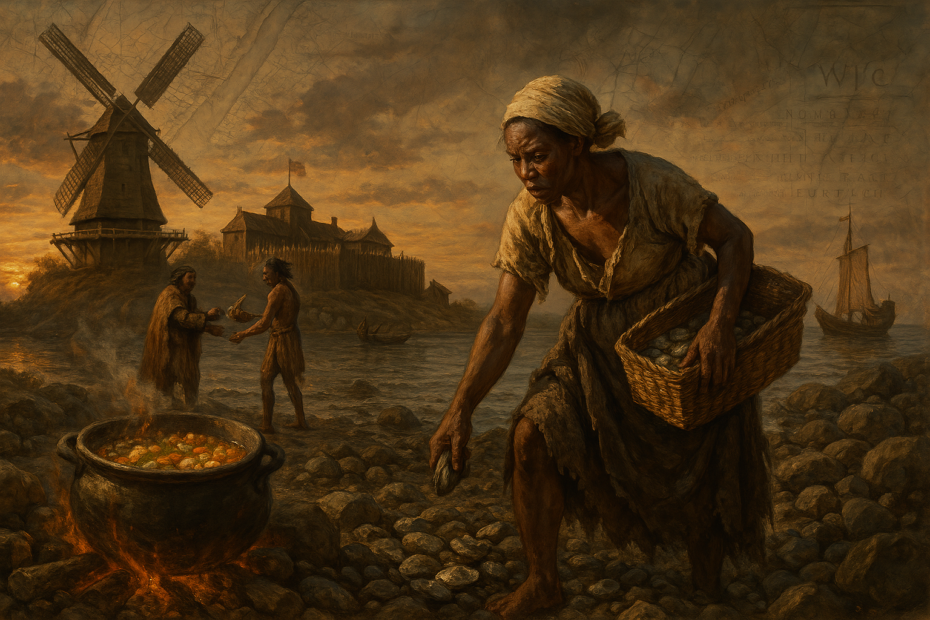Summary
New Amsterdam, established in 1626 as a Dutch colonial outpost on the southern tip of Manhattan Island, relied heavily on enslaved labor to build its infrastructure, farms, and defenses. While the Dutch are often remembered for their relatively pragmatic legal system—including permitting enslaved individuals limited rights—their colonization was undeniably tied to the brutal transatlantic slave trade and the sustenance provided slaves was not born of altruism, but of the colony’s fragile economy and labor needs.
The Colonial Food System
Enslavers, primarily the Dutch West India Company (WIC) and private colonists, provided minimal sustenance to enslaved laborers. Archival records from the 1660s outline weekly rations as “half a bushel of maize, four pounds of pork, and half a barrel of small beer” per person. These rations were neither consistent nor sufficient. Maize, often ground into coarse meal, formed the dietary staple, while salted pork supplied meager protein. “Small beer,” a low-alcohol brew, was intended to hydrate workers without impairing productivity.
Archaeological findings from Manhattan’s African Burial Ground corroborate written accounts. Skeletal remains reveal dental wear patterns consistent with diets heavy in unprocessed grains, alongside evidence of malnutrition and vitamin deficiencies.
Self-Supplemented Diets
Enslaved individuals actively supplemented their diets through ingenuity and clandestine labor. Small garden plots yielded beans, squash, and leafy greens—crops that echoed West African agricultural traditions. Foraging expanded these resources: wild garlic and nutrient-rich greens like purslane were gathered from forests and marshes. Shellfish, particularly oysters harvested from the Hudson River estuary, provided critical protein.
The fusion of African and Indigenous knowledge further enriched foodways. Enslaved cooks adopted the Lenape “Three Sisters” agricultural system, interplanting corn, beans, and squash to maximize yield and nutrition. Dishes like succotash—a stew of maize and beans—became culinary cornerstones, blending First Nations ingredients with West African one-pot cooking techniques.
Seeds of okra and black-eyed peas, smuggled aboard transatlantic ships, were cultivated in New Amsterdam’s soil. These crops anchored dishes like gumbo, a stew that would later become central to African American cuisine.
Food preparation also retained African techniques. Ash-roasting, a method involving burying corn or tubers in embers, circumvented the need for European cooking implements. Fermentation, used to preserve vegetables, mirrored practices from the Senegambia region.
Enslaved women, often tasked with cooking for both enslavers and their own communities, played a pivotal role in sustaining cultural foodways. “Cookfires” became sites of dual labor: meals for colonists were prepared alongside covert gatherings. That fire wasn’t just for cooking—it was a chatroom, a pharmacy, and a protest sign all in one. They’d simmer bitter greens to fight off scurvy, brew sassafras tea for aches, and whisper gossip while stirring pots of hoecakes (cornmeal patties cooked on agricultural tools—symbolized this duality, sustaining laborers while subtly mocking the tools of oppression).
Cultural Retention and Culinary Innovation
Enslaved cooks preserved ancestral traditions through dishes like calalou (a stew of greens and shellfish) and funje (a cassava porridge). Ash-roasted yams and corn, seasoned with pepper seeds smuggled from Africa, offered a tangible link to displaced cultures.
The Dutch tolerance for limited autonomy inadvertently enabled cultural retention. Enslaved women sold surplus goods at markets, exchanging recipes with First Nation and European traders. This exchange laid groundwork for New York’s street food culture: by the 1650s, vendors sold roasted nuts, fried fish, and corn cakes near the East River docks.
Legacy of the enslaved diet
The culinary legacy of New Amsterdam’s enslaved population extends far beyond the colonial period. Dishes like succotash, hoecakes, and pickled greens laid the foundation for Southern and African American cuisine.
The diet of enslaved people in New Amsterdam exemplified resilience and cultural synthesis. Through gardens, foraging, and the preservation of African traditions, enslaved communities transformed scarcity into sustenance. Their culinary innovations became enduring acts of resistance, weaving First Nation, African, and European elements into a distinctly American culinary tradition.
The Dutch experiment in “negotiated slavery” collapsed when the English seized New Amsterdam in 1664, imposing harsher chattel slavery laws. Yet the legacy of New Amsterdam’s enslaved population endured. Descendants of “half-free” families, like the Manuel and Van Angola clans, became prominent landowners in early Black Manhattan. Their agricultural knowledge shaped the colony’s food systems, influencing dishes like New York’s oyster stew and bean pies.
Recommended reading
- Cantwell, Anne-Marie, and Diana diZerega Wall. The Archaeology of Slavery in New Netherland. 2023.
- Carney, Judith A. Black Rice: The African Origins of Rice Cultivation in the Americas. Harvard University Press, 2001.
- Haefeli, Evan. New Netherland and the Dutch Origins of American Religious Liberty. University of Pennsylvania Press, 2012.
- Twitty, Michael W. The Cooking Gene: A Journey Through African American Culinary History in the Old South. HarperCollins, 2017.
- Van Laer, Arnold J.F. (translator). New York Historical Manuscripts: Dutch. Baltimore: Genealogical Publishing Co., 1974.
[IMAGE SOURCE: AI/LESHP]

Eric is a 4th generation Lower East Sider, professional NYC history author, movie & TV consultant, and founder of Lower East Side History Project.
